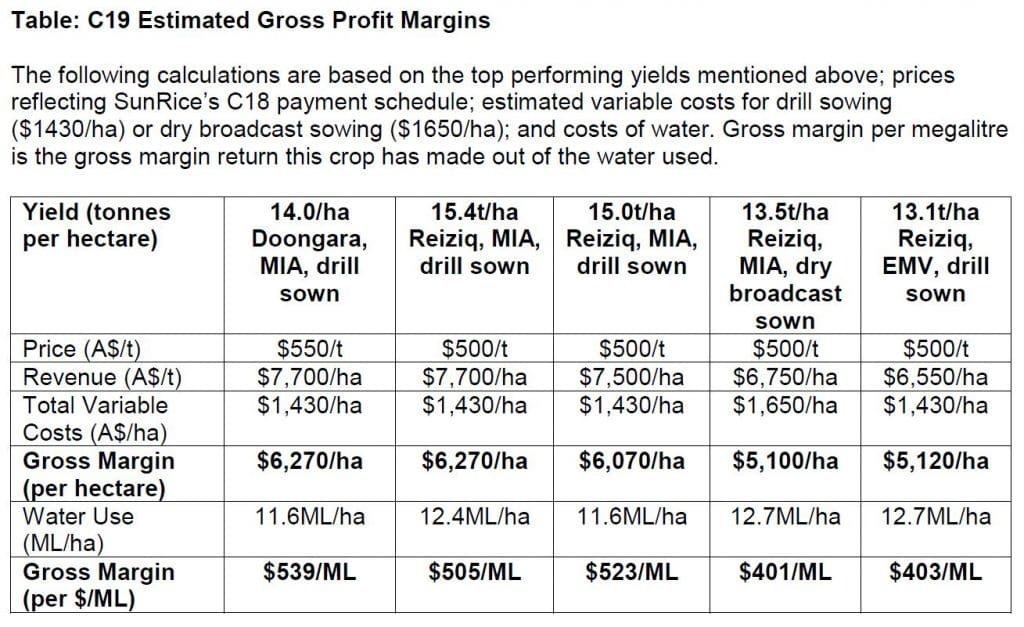LOW water availability and high water prices have seen just 54,000 paddy tonnes of rice harvested in the Riverina this season, a fraction of the 2018 crop of 623,000 tonnes and the second lowest recorded since the start of the Millennium Drought in 2003.
With the 2019 harvest now completed, SunRice general manager global agribusiness and sustainability Tom Howard said despite water-related challenges and seasonal conditions fluctuating from extreme heat to the occasional cold snap, Riverina growers had once again shown their resilience and expertise.
“Overall yields were above the five-year average, with a grower in the Murrumbidgee Irrigation Area (MIA) achieving a standout 15.4 tonnes per hectare for a medium grain Reiziq crop, 30 per cent above the region’s five-year average of 11.8 tonnes per hectare,” he said.
“This season also saw the best Doongara (Low GI) yield recorded. Grown in the MIA, the crop yielded 14 tonnes per hectare, far outstripping the region’s five-year average of 11.3 tonnes per hectare.
“Both these crops were drill sown, a technique that is growing in popularity and was used across 70pc of the area grown to rice this year. A combination of improved irrigation layouts, machinery technology and available weed control options ensured drill sowing has delivered top yields with decreased water use. Growers reported between one to two megalitres per hectare less water use compared to crops grown using other methods.”
The high yielding Reiziq crop was grown using 12.4 megalitres of water per hectare and the Doongara crop used 11.6 megalitres of water per hectare, with both crops exceeding the targeted industry benchmark of 1 tonne/megalitre of water.
Once again, this season there were a number of exceptional results achieved on a gross return per megalitre and hectare, as outlined in the table below, including these highlights:
- The Reiziq crop generated an estimated gross profit margin of $6270/ha (or $505/ML); and
- The Doongara crop delivered an estimated $6270/ha (or $539/ML).
Harvest Highlights
While the majority of the 2019 crop was planted to Reiziq (73pc of the area), other varieties grown included:
- Doongara, which is used in SunRice’s Low GI range sold in domestic and exports markets;
- Topaz, which is a Jasmine variety that is popular in Asian cuisine;
- Viand, the new short-season medium grain variety that was launched in 2018, offering growers a late planting, double cropping option, providing flexibility and potentially lower water-use compared to existing longer season varieties;
- Langi, a soft cooking long grain popular in the domestic market;
- Opus, a short grain for the Asian market, particularly in sushi; and
- Koshihikari, a premium short grain variety for the sushi market.
Other standout results included:
- A drill sown crop of Reiziq in the Eastern Murray Valley produced 13.1t/ha, 3.3t/ha above the five-year average for the region of 9.8t/ha.
- The top performer in the Coleambally Irrigation Area was a drill sown crop of Reiziq that yielded 13.2t/ha, 3.0t/ha above the region’s 10.2t/ha five-year average.
- 15pc of the total Reiziq area was above 13t/ha, while 34pc of the total Reiziq area above 12t/ha.
- On the whole drill sown crops performed better than other sowing methods. For example, a drill sown crop of Reiziq in the MIA yielded 15t/ha compared to a dry broadcast sown crop of Reiziq that was grown beside it and yielded 13.5t/ha. The drill sown crop used 1.1 megalitres of water per hectare less than the dry broadcast crop. Water use efficiency was 1.3 tonnes per megalitre and 1.1 tonnes per megalitre respectively.
- A special mention goes to a crop of organic Viand, which yielded 9.5t/ha, the best yield and lowest water use ever recorded by that grower and almost double the longer-term average for organic crops.
- Viand consistently performed well across all regions. On average Viand yielded around 0.5t/ha below Reiziq, or 95pc of the Reiziq average – an impressive result given it has a sowing date of three to four weeks after Reiziq.
- The value of rice goes beyond harvest, with many growers baling their rice straw to sell for animal feed and sowing wheat crops into their rice stubble, taking advantage of remnant ground moisture and recent rains.
Price uplift
The SunRice Board has announced that the lower end of the price range in the C18 Pool for base grade medium grain (Reiziq) has been increased by $15/t for the 2018 crop (for rice harvested in 2018 and marketed in the financial year just ended on 30 April 2019).
The estimated range for base grade medium grain (Reiziq) is now $400/t – $410/t, from the previous guidance of $385/t – $410/t. This follows the $25/t uplift announced in February and represents a total increase of $45/t since the C18 pool opened. Payment of the additional $15/t was made to growers on Thursday 23 May 2019.
SunRice chairman Laurie Arthur said the adjustment was approved by the Board based on the strong finish to the financial year that SunRice had experienced and the ongoing strategy to deliver premium prices for Riverina rice in key domestic and international markets.
“With prospects improving for winter cropping following the recent rain across the Riverina and in the catchment, we hope this price uplift provides growers with a timely cashflow injection. We also hope the seasonal outlook continues to improve as we head into C20,” he said.
“We remain hopeful that, as we close out the year, a further price uplift for C18 could be delivered, dependent on final audited results and year-end adjustments.”
……………………………………………………………………………………………………………………..
Video: Harvest highlights, including commentary from Sunrice’s Tom Howard and Willbriggie grower, Robert Andreazza, who grew the record 14 tonne per hectare Doongara crop.
Source: Sunrice





HAVE YOUR SAY